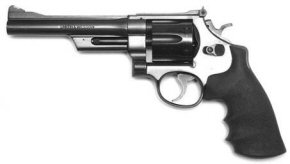Repairing a Smith & Wesson Model 28 Highway
Patrolman
by Roy Seifert
Click here to purchase a
CD with this and all Kitchen Table Gunsmith Articles.
Disclaimer:
This article is for entertainment only and is not to
be used in lieu of a qualified gunsmith.
Please defer all firearms work to a qualified
gunsmith. Any loads
mentioned in this article are my loads for my guns and have
been carefully worked up using established guidelines and
special tools. The
author assumes no responsibility or liability for use of
these loads, or use or misuse of this article.
Please note that I am not a professional gunsmith,
just a shooting enthusiast and hobbyist, as well as a
tinkerer. This
article explains work that I performed to my guns without
the assistance of a qualified gunsmith.
Some procedures described in this article require
special tools and cannot/should not be performed without
them.
Warning:
Disassembling and tinkering with your firearm may
void the warranty. I
claim no responsibility for use or misuse of this article.
Again, this article is for entertainment purposes
only!
Tools
and firearms are the trademark/service mark or registered trademark
of their respective manufacturers.

In
my firearms collection I have a 30+ year old Smith &
Wesson Model 28 Highway Patrolman .357 magnum.
Smith & Wesson built the Highway Patrolman on
their .44 magnum N frame making it beefier for handling
higher-pressure loads. This
gun was built for law enforcement use, and was really a less
expensive version of the highly polished target model 27.
I
no longer shoot this gun and decided to sell it to a friend.
I may regret this decision later, but I have other
uses in mind for the money.
I had packed the gun into a padded gun rug and was in
the process of bringing it to my friend’s house, when I
dropped it onto the cement floor of my garage!
It was raining that day and I was juggling the gun,
an umbrella, car keys and alarm fob, and the gun rug slipped
out of my hand.

I
took the gun out of the rug and couldn’t find any outward
evidence of the drop. But,
when I tried to cycle the action, the cylinder jammed.
When I opened the cylinder I noticed the center pin was
stuck in the unlock position.
I took the gun into my shop, removed the yoke screw
(the frame screw closest to the barrel), and removed the yoke
and cylinder assembly from the frame.
I removed the cylinder assembly from the yoke and
placed it into a padded vise with the extractor rod up.
I wrapped a piece of leather around the extractor rod,
and using pliers, rotated it clockwise
to unscrew the rod. Yes,
this has a left-handed thread, so normal cylinder rotation
will have a tendency to tighten the rod to prevent it from
coming loose.

When
I removed all of the parts from the cylinder assembly, I found
I could not remove the center pin.
I had to use a punch to push it out.
Upon closer examination, I found the end of the center
pin had been displaced 0.005” causing it be off-center.
Apparently, this happened because the revolver landed
on the cylinder with enough force to cause the center pin to
be displaced where it entered the recess in the frame.
Now that this was off-center, the cylinder did not
rotate evenly and would jam.
I checked to see if any other parts were damaged,
including the recess in the frame, but all seemed to be ok.
I ordered a
new center pin, part number 940-072-750 from Brownells,
which arrived a couple of days later.
I reassembled the cylinder and again used a padded vise
and leather to make sure the extractor rod was nice and tight.
I reassembled the gun and found that the new center pin
was too long, which would not allow the cylinder to close.
I used my high-speed rotary tool with a cut-off wheel
and removed about 1/8” from the end of the pin.
It now fit correctly.
With the
gun reassembled, I cycled the action and checked for proper
cylinder alignment with the barrel by using a dowel rod.
Everything seemed to work well, and the cylinder
aligned properly with the barrel.
So, for the price of parts and postage, I was able to
repair the revolver myself.
I
sold the revolver to my friend, who seems pleased with his
purchase. This was
an easy fix, but I had to remember that the extractor rod had
a left-hand thread.
|